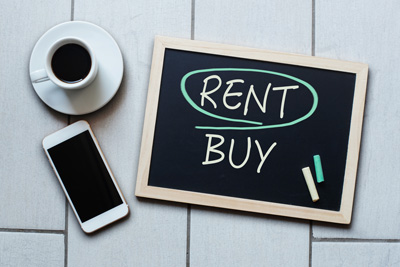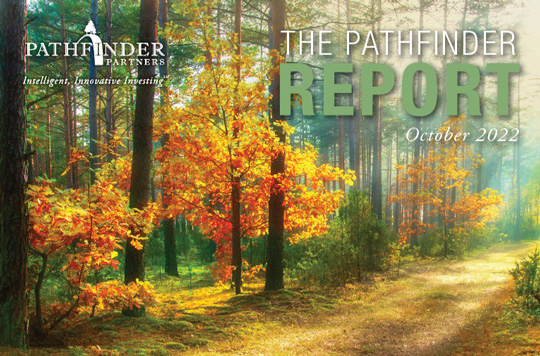Finding Your Path
A Bumpy Ride Ahead for Housing
By Lorne Polger, Senior Managing Director

I’m concerned. Very concerned.
After the Federal Reserve’s latest interest rate hike last week, the average 30-year mortgage rate topped 6.5%. That’s the first time since 2008 that the rate has been this high. And, given the hawkish mood of the Federal Reserve Board to stamp out the rising tide of inflation, it ain’t over – the next Fed meeting is in November and, as we sit here today, another rate hike is virtually assured. Could we see 7% rates on 30-year mortgages by year-end? Probably. And 8% next year? Maybe. Consider this. The average mortgage rate in 2021 was below 3%. So, rates have more than doubled in a year. And there’s likely more to come.
Not surprisingly, mortgage applications are way down. Applications for home mortgages dropped in late August to a 22-year low as potential buyers balked at the combination of high home prices and elevated interest rates. Year over year, mortgage applications are down almost 30%. And the refinance market? Fuhgeddaboudit. Refinance demand is down 83% year over year. And with rates above 6%, a mere half a million borrowers could benefit from a refinance, according to Black Knight, a mortgage technology firm and data provider. That is the lowest number on record. And it may be going lower.
The National Association of Realtors (“NAR”) also reported that its pending home sales index was down 19.9% from July last year. The number of signed contracts to buy previously owned homes is now at the lowest level in two years. Meanwhile, new home sales fell for the sixth straight month in July to the lowest level since 2016.
 Housing starts, a measure of new home construction, also plunged this summer as the cost of building supplies and construction labor remained high and prospective buyers were priced out of the market. Unsold inventory sits at a 3.3-month supply at the current sales pace, up from 2.9 months in June and 2.6 months in July 2021. While 3.3 months of supply is still a healthy level, the trend isn’t great.
Housing starts, a measure of new home construction, also plunged this summer as the cost of building supplies and construction labor remained high and prospective buyers were priced out of the market. Unsold inventory sits at a 3.3-month supply at the current sales pace, up from 2.9 months in June and 2.6 months in July 2021. While 3.3 months of supply is still a healthy level, the trend isn’t great.
And in Pathfinder’s markets in the western U.S., existing-home sales retracted 9.4% month over month to an annual rate of 870,000 in July, down 30.4% from this time last year. The median price in the West was $614,900, an 8.1% jump from July 2021. Lawrence Yun, the NAR’s long-time chief economist noted that: “The action is in the pricey West region which experienced the sharpest sales decline combined with a sizable inventory increase. It’s likely some Western markets will see prices decline...” Likely Lawrence. He’s always been a bit understated.
In a rising tide, everyone wants to jump on the ship. I did back in June 1989 when I purchased my first home in San Diego. (Full disclosure; we closed the day the market peaked. Ugh. I sold my home six years later at a loss; of course, it’s worth a small fortune today.) All my peers told me I was a fool to rent. After I heard it enough times, I convinced my wife to jump in.
Over the last decade, we’ve seen meteoric growth in home valuations, and especially so over the last couple of years, where prices rose 30% or more in some markets. As the tide rose, many tried to jump on the boat. More wanted to but struggled to come up with the down payment as the regulatory environment largely eliminated low down payment loans and buyers struggled with large student loans and other consumer debt. As we’ve written about over the years, this, in part, resulted in a significant decrease in homeownership, from a high of 69.2% in 2004, to a low of 62.9% in 2016, to the most recent reported level of 65.8% in the second quarter of 2022.
Demographers expect further declines in the years ahead and higher mortgage rates will accelerate that trend. Here’s the math.
Mr. and Mrs. Smith find the new home of their dreams in Happy Acres. They’ve saved for years and are ready to put the big deposit down. They are purchasing the house for $800,000 and getting a mortgage for $600,000. The monthly principal and interest payment on a 30-year loan at today’s interest rate of 6.5% is $3,792. That’s more than $1,200/month, 50% above the payment of $2,530 that they would have had at the 3.0% interest rate from last year. Big change.  When you then tack on the costs of taxes and insurance (and potentially HOA fees), the number climbs well beyond the costs of renting that same home. How much more? A June report issued by John Burns Real Estate Consulting noted that having a mortgage cost $839 more per month than having a lease; $200 more than at any time in the past 20 years. Nationally, the cost of owning is 31% higher than renting, although the disparity is even higher in metro areas where housing prices have surged (38% in Denver and 35% in Phoenix in just the past two years). Their report is three months old; the disparities are likely greater now given higher interest rates.
When you then tack on the costs of taxes and insurance (and potentially HOA fees), the number climbs well beyond the costs of renting that same home. How much more? A June report issued by John Burns Real Estate Consulting noted that having a mortgage cost $839 more per month than having a lease; $200 more than at any time in the past 20 years. Nationally, the cost of owning is 31% higher than renting, although the disparity is even higher in metro areas where housing prices have surged (38% in Denver and 35% in Phoenix in just the past two years). Their report is three months old; the disparities are likely greater now given higher interest rates.
It costs significantly more now to own than rent, that cost is likely increasing, and the Smiths have been reading lots of recent news stories opining that home prices may be “correcting” to the tune of 5-20% over the next year or two. What do they do? Most likely, they keep renting. Inflation has already stretched their budgets and the last thing they need is to exacerbate that problem. In 2021, the Urban Institute forecast that the homeownership rate in the U.S. would fall to 62% by 2040, and that the pace of renter growth will be more than double the pace of homeowner growth from 2020 to 2040.
What happens next? Builders slow their construction of new homes, even though we’ve significantly under-supplied housing across the U.S. If you’re a builder, the last thing you want is standing inventory – you’re all about turning your inventory quickly and paying down your construction debt. The weak sister homebuilder cuts prices to stimulate sales and competitors follow. At some point, prices fall as demand shrinks and builders need to get that inventory off their books. Ripple effects occur in the space, as the reduction in building affects demand for materials and labor, driving those costs down. Meanwhile, rental rates likely continue to climb because of increasing demand for rental housing – keep in mind that we have also continually under-supplied rental housing in the U.S.
Not a perfect storm, by any means, but I’m forecasting a bumpy ride ahead in the housing sector.
Lorne Polger is Senior Managing Director of Pathfinder Partners. Prior to co-founding Pathfinder in 2006, Lorne was a partner with a leading San Diego law firm, where he headed the Real Estate, Land Use and Environmental Law group. He can be reached at lpolger@pathfinderfunds.com.
Share this Article
IN THIS ISSUE
PATHFINDER PARTNERS INCOME FUND, L.P.
A Stablized Multifamily Fund
CHARTING THE COURSE
Dazed and Confused
FINDING YOUR PATH
A Bumpy Ride Ahead for Housing
POINT/COUNTERPOINT
The Death of Office Space?
The Future of OfficeZEITGEIST
Sign of the Times
TRAILBLAZING
East of Eleven, Portland, OR
NOTABLES AND QUOTABLES
Humility
